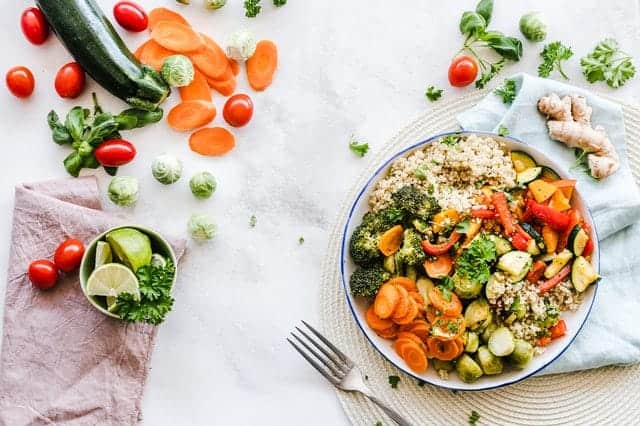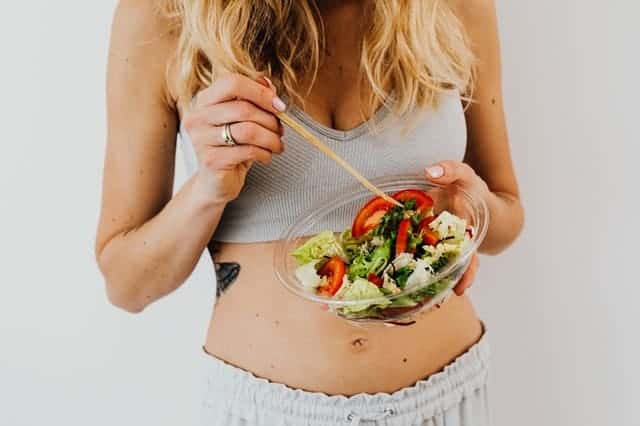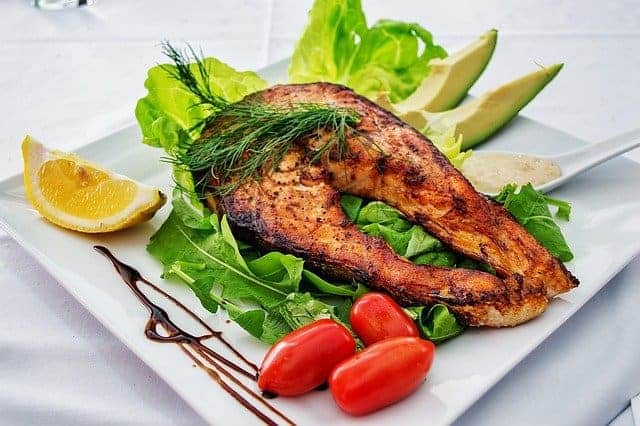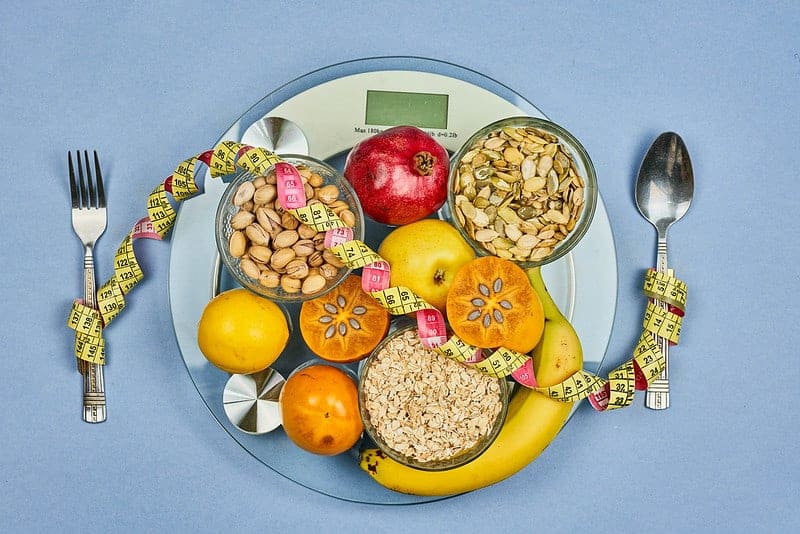Reduction diet is an effective method of burning the unnecessary fat and developing a slim figure, which can then be modeled at will, emphasizing these or other parts of muscle. If, looking at your figure, you come to the conclusion that the level of fat tissue is too high, reduction diet is for you. It is best to add to it regular physical activity, and positive effects will appear immediately. Read the article and find out how to eat, what to eat and what to definitely avoid in order to actively burn fat!
Table of contents
- 1 Reducing fat is the first step in the body shaping process
- 2 Effective, efficient, dynamic reduction – a calorie-restricted diet is the key to burning fat stores fast
- 3 Reduction diet – rules in 6 simple points
- 4 Active fat reduction – what can you do to intensify the effects?
- 5 Fat loss diet – what to eat and what to avoid (recommended and undesirable products)
- 6 Reduction diet menu
Reducing fat is the first step in the body shaping process
Conducting a reduction diet will allow us to get rid of excess fat in various parts of the body, and thus build ourselves a foundation for further muscle formation. Many people ask themselves: what comes first – reduction or mass. The answer is simple – if your body is too fat (the level of body fat exceeds 25%), reduction should be our starting point.
There is no point in building muscle mass and creating the dream muscles if the level of body fat is too high. In overweight people the effects of strength training, aimed at mass gaining and muscle sculpting, are weaker and slower than in people with low levels of body fat, and calories from food are more easily accumulated in the form of fat tissue, instead of being used by muscles as a source of energy. It is therefore better (at least partially) to reduce fat surpluses and only then start to build muscle.
When it is worth doing a diet for reduction:
- when you want to build a foundation for further body shaping,
- when you want to improve your health, regulate metabolism and improve insulin balance,
- when you want to enjoy good mood and impress with your athletic body,
- when you want to get rid of excess fat, achieve correct BMI and work out a nice, slim figure.
Effective, efficient, dynamic reduction – a calorie-restricted diet is the key to burning fat stores fast

Anyone who is trying to reduce body fat is probably aware that the basis is a properly composed diet. To start burning fat intensively, we need to create an energy deficit, among other things by reducing the calorie content of the entire menu and eliminating processed food, which is generally the main culprit in the issue of weight gain.
If we manage to systematically, preferably every day, achieve an energy deficit, i.e. a state in which we supply the body with less energy in food than it needs to perform all its functions, this will result in regular recourse to fat reserves in order to acquire the required amount of fuel. In this way we will accelerate the process of breaking down body fat, losing weight and slimming down our figure.
Generally speaking, a reduction diet involves depleting the number of calories we consume daily in order to burn more calories than we eat. However, when it comes to details, the menu should be adapted to our lifestyle, mainly to the level of physical activity. So before we move on to composing a new menu and determining the size of meals, we need to establish our daily calorific needs. The easiest way to do this is to look at calorie demand calculators and tables available on the internet.
Example: for an adult male fairly physically active (e.g. training intensively 3 times a week), caloric demand is about 2800 kcal. The most effective, best diet for fat reduction in this case is one in which we consume daily about 2300-2500 kcal (that is about 300-500 kcal less).
Important note – calorie deficit can not be too large. If we cut the calories we eat too much, we risk nutritional deficiencies, deterioration of health and well-being, metabolic disorders, disorders of the mind. We can also, after rapid weight loss, very quickly expect a yo-yo effect.
Many times when we radically reduce the calorific value of our menu, e.g. by 1000 kcal, metabolism slows down considerably and our body, sensing the lack of sufficient food as a harbinger of approaching hunger, begins to meticulously store reserves, obviously in the form of fat tissue. In this case our reduction will be useless.
Reduction diet – rules in 6 simple points

Reduction diet is a method for regular weight loss, slimming down the silhouette and giving it a dynamic, athletic look. It is most often used by active people and combined with training for reduction. Its basic principles can be summarized in a few points. Here they are:
- We get rid of old eating habits in which we ate more calories than we are able to burn on a regular basis.
- Avoid products that cause rapid fluctuations in blood sugar levels (products with a high glycemic index), including white flour products, sweets, processed foods.
- Increase the amount of protein (daily intake of about 1.5 g – 2 g of protein for each kilogram of body weight) and dietary fiber in the diet.
- We determine what is our daily caloric demand. We try to build a menu so that every day we eat 300-500 kcal less than this demand. Exactly how many calories to cut – everything depends on the reaction of our body. We have to observe ourselves if, for example, when reducing 300 kcal a day weight loss occurs or not. If not, we can cut another 100 or 200 kcal.
- We eat more often but less. The rule of eating 5 meals a day every 3 hours (3 larger meals plus 2 small ones) will be the optimal option here. Consuming a dietetic, but valuable meal every 3-4 hours, our metabolism constantly keeps on higher revolutions, what is more, we do not condemn ourselves to attacks of strong hunger, which often end up in eating uncontrollable amounts of food.
- We try to be accompanied by physical activity every day. There is no better way to rapidly lose weight than to combine diet with training. Shorter but quite intensive training sessions work best during the reduction cycle. We can use a combination of aerobic training (e.g. 25 minutes on a treadmill) with strength training (exercises with barbells) or interval training. Systematic, dynamic activity will strengthen our muscles, permanently increase metabolism and intensify the process of transforming fat into energy, and a low-calorie diet will help us stop gaining weight.
Active fat reduction – what can you do to intensify the effects?

As already mentioned, if we want to intensify the fat burning process, it is worth introducing a reduction training at the same time as the diet. If you decide on both a diet and a workout, remember to eat a meal with a high content of protein and complex carbohydrates with a small amount of healthy fats about 2 hours before and after exercising.
And immediately after the workout (max. 30 minutes after), it’s worth reaching for a portion of simple carbohydrates (preferably in the form of fruit or juice) to “feed” your muscles and replenish energy resources.
At the same time as dieting and training, many people take supplements to speed up fat burning. Is it a good solution? Of course it is, provided that you use high-quality products tailored to the needs of people who want to lose weight quickly and efficiently (check: Fat Burners Ranking).
Fat loss diet – what to eat and what to avoid (recommended and undesirable products)

Menu in the reduction diet should be rich in protein, vitamins and minerals. It should also not lack complex carbohydrates, the best sources of which are products from whole grain cereals. To every meal we should add vegetables or fruit (or both), because they are very valuable from the point of view of slimming figure – they are rich in dietary fibre, support digestion, are filling, prevent hunger attacks, give energy and vitality.
When composing meals, we base them on:
- lean meats (e.g. turkey and chicken breast, ham and pork tenderloin),
- Sea fish (e.g. hake, cod, pollock, salmon),
- vegetables,
- legumes,
- fruit,
- Lean dairy products (e.g. cottage cheese, natural yoghurt, kefir, buttermilk, curdled milk),
- eggs,
- Lean meats,
- whole grain products (wholemeal bread, brown rice, wholemeal pasta, groats, bran, cereals).
In addition, the daily menu should include vegetable oils (the most valuable are those cold-pressed), coconut oil, olive oil, fresh herbs (such as parsley, basil, dill), spices (such as ginger, turmeric, oregano, cinnamon, chili, pepper, garlic), as well as various seeds, seeds and nuts.
We avoid foods such as:
- fast food, ready meals, instant soups,
- fatty meats and cold cuts,
- meat breaded in breadcrumbs and fried (instead, you can make a breadcrumb coat of, for example, crumbled oatmeal and bake the meat),
- highly processed meats (e.g. tinned foods, sausages, pâtés),
- heavy, floury sauces,
- French fries,
- white bread,
- white pasta,
- Noodles, cakes, pancakes made from white flour (white flour may be replaced by wholemeal flour),
- sweets and salty snacks such as crisps,
- savoury products,
- coloured sweetened drinks.
Read the review of Cappucino MCT Slimming Coffee

Reduction diet does not have to be sterile or monotonous. We have a wide range of vegetables, fruits, fish, lean meats, herbs, seafood, cereals, dairy products, which can be used to create a variety of imaginative dishes, while maintaining the principles of dietetics. Let’s take care of diversity in the kitchen and show culinary creativity, and reducing diet will be a real pleasure for us.
Menu in a reducing diet may look like this:
- Breakfast: scrambled eggs with smoked salmon, chives and dill, 2 slices of pumpernickel, cucumber as an addition
- 2 breakfast: oatmeal on yoghurt with blueberries and cherries (optionally with other fruit)
- Lunch: casserole with yams, courgettes, tomatoes, onions, peppers, chili peppers, garlic, peas, herbs with smoked cheese and mozzarella
- Snack: carrots with hummus, buttermilk and strawberry cocktail
- Dinner: a graham with tuna, olives and cottage cheese paste, lettuce, radishes
- Breakfast: wholemeal toast with chicken ham and feta cheese, glass of grapefruit juice
- 2nd breakfast: omelette with eggs and bran decorated with fruit (e.g. oranges, tangerines, kiwi, peaches)
- Dinner: broccoli and cauliflower soup, second course: brown rice, turkey fillet baked in herbs, carrot salad
- Tea time: yoghurt with nuts and seeds
- Dinner: parma ham rolls stuffed with hard-boiled eggs, chives and rocket (or fresh spinach)
- Breakfast: salad with brown rice, chicken and vegetables, orange juice
- 2nd breakfast: pudding with chia seeds, milk and mango
- Dinner: cream soup with lentils, buckwheat groats, fish in oatmeal coating, Chinese cabbage salad
- Tea time: cottage cheese with radishes, cucumber, chives, slices of wholemeal bread
- Dinner: wholemeal roll with vegetable paste, kabanos, peppers and lettuce
Sources:
https://www.healthline.com/nutrition/30-ways-to-lose-weight-naturally
https://www.healthline.com/nutrition/12-fat-burning-foods
https://www.medicalnewstoday.com/articles/324130
https://www.medicalnewstoday.com/articles/215100

